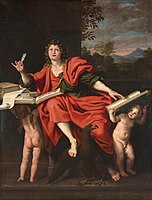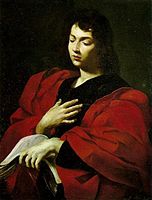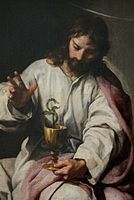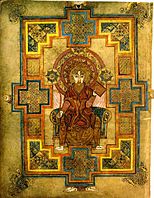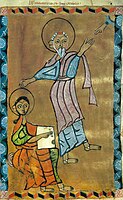Yohane
Yohane Sanura Injil | |
|---|---|
 Gambara Yohane Sanura Injil ba zandrela gereja paroki SS Mary and Lambert, Stonham Aspal, Suffolk, Inggris | |
| Sanura Injil, Nifahaö, Teolog | |
| Tumbu | ba gotalua a.t döfi 6-9 |
| Mate | a.t. 100[1] |
| Tefolakhömi ba | Gereja Katolik Gereja Katolik Timur Gereja Ortodoks Timur Fa'awösa Gereja Anglikan Gereja Lutheran |
| Owasa khönia | 27 Desember (Niha Keriso Barat); 8 Mei ba 26 September (Gereja Ortodoks Timur) |
| Simbol | Moyo, Mako (Piala), Gölu-Gölu Zura |
| Sinurania | Turia Somuso Dödö nisura Yohane Sura Yohane Fama'ele'ö |
Yohane (li Yunani Ἰωάννης; li Aramaia ܝܘܚܢܢ; li Ge'ez ዮሐንስ; li Arab يوحنا الإنجيلي; li Latin Ioannes; li Ibrani יוחנן; li Koptik ⲓⲱⲁⲛⲛⲏⲥ ma ⲓⲱ̅ⲁ) ma Yohane Sanura Injil ba asese göi latötöi ia Santo Yohane no samösa niha sanura sura Yohane molo'ö miŵaö ndra tua meföna (tradisi). Bakha ba tradisi laŵaö niha Keriso wa Yohane andrö no fagölö ira Yohane nifahaö Yesu, Yohane moroi ba Patmos ba Yohane Satua Niha Samati,[2] heŵa'ae no latenaŵa da'a arakhagö fefu gere Zura Ni'amoni'ö modern.[3]
Haniha ia (identitas)
[bulö'ö | bulö’ö kode]
I'ombakha'ö injil Yohane wa so samösa "nifahaö ni'omasi'ö Yesu" si lö mutötöi töi, si no "mamaduhu'ö ba manura" turia injil.[5] Hulö na sanura injil andre, i'odödögö wamini'ö haniha sibai döi zanura ya'ia. Na tafaedogö zi tölu injil sinoptik[6] ba na ta'angeragö wa töi zanura ya'ia Fetero awö na tatörö tödö wa Yakobo no tobali martir[7] me ndröfi 44,[8] arakhagö gofu heza faduhu dödö niha wa sanura andrö no Yohane nifahaö Yesu (heŵa'ae so zanguma'ö wa ha ibe'e hulö ya'ia zanura).[9]
Iŵaö tradisi niha Keriso wa Yohane Sanura Injil andrö no Yohane nifahaö Yesu samösa. Baero Wetero ba Yakobo, Yohane no samösa moroi ba gotalua zi datölu gehomo gereja ba Yerusalema aefa wa'amate Yesu.[10] No samösa ia moroi ba gotalua nifahaö si felendrua. Molo'ö tradisi ya'ia nifahaö fondrege awuyu ndröfi ba safuria mate moroi ba gotaluara fefu. Laŵaö wa alaŵa sibai ndröfinia ba mate ia me irugi inötönia ba Nefeso aefa ndröfi 98, götö wamatörö kaisaro Traian. Börö da'ö moroi ba gotalua ndra nifahaö ha Yohane zi lö mate tobali martir.
Laŵaö wa a.t. döfi 95 latibo'ö ia ba hulo Patmos, heza isura mbuku Wama'ele'ö. Ba hiza so ösa zanguma'ö wa sanura buku Wama'ele'ö no samösa niha bö'ö sotöi Yohane Satua Niha Samati ma zui niha bö'ö si lö ta'ila töi.[11] Iforege Bauckham wanguma'ö wa khö ndra niha Keriso si föföna no fagölö ira Yohane Sanura Injil andrö ba Yohane Satua Niha Samati.[12]
Sanura ngawalö zura Yohane
[bulö'ö | bulö’ö kode]No fabago zöndra ndra ere Zura Ni'amoni'ö i'otarai ngaotu ndröfia si-2 ba zanadrösa ba haniha zanura oi ngawalö zura Yohane (Injil Yohane, tölu zura Yohane ba sura Wama'ele'ö).[13] Tuho nifadönira ya'ia haniha zanura oi sura andrö ba hezo zura nisura Yohane ni'ilada.
Iböbögö tradisi Ortodoks Timur zanura fefu zura Yohane khö Yohane nifahaö Yesu.[2]
Ba ngaotu ndröfia si-6 iŵaö Decretum Gelasianum wa sanura Sura Yohane II ba Sura Yohane III no samösa niha bö'ö sotöi "Yohane, samösa ere" (faigi göi Yohane Satua Niha Samati).[14] Ira ere sejarah simane H.P.V. Nunn,[15] ba ere sejarah si tenga niha Keriso simane Reza Aslan,[16] ba Bart Ehrman,[17] lö latema wa Yohane nifahaö Yesu zanura oi zura Yohane, lö na'i sambua ba gotalua zura andrö.
Faduhu dödö arakhagö fefu gere zura Ni'amoni'ö modern wa lö sambua zura Yohane nisura Yohane nifahaö Yesu.,[18][19] heŵa'ae so ösa ira simane J.A.T. Robinson, F.F. Bruce, Leon Morris ba Martin Hengel,[20] sanguma'ö wa si lö'ö-lö'önia sambua ba gotalua zura Yohane, töra-töra Injil Yohane, no nisura Yohane nifahaö Yesu.[21][22]
Tola manö wa injil Yohane ba si tölu zura Yohane no nisura samösa niha.[2] Bahiza so ösa ere Zura Ni'amoni'ö sanguma'ö wa sanura zura Yohane fabö'ö moroi ba zanura injil Yohane, heŵa'ae fefu ia te'a'asogö moroi ba sambua komunitas.[23] Molo'ö tradisi injil Yohane ba sura Yohane tohare moroi ba Nefeso, a.t. 90-100, heŵa'ae so gere Zura Ni'amoni'ö sanguma'ö wa moroi ba Suriah oi zura andrö.[24]
Na manandrösa ba zura Wama'ele'ö, fao dödö arakhagö fefu gere Zura Ni'amoni'ö wa sanura ya'ia no niha bö'ö, ya'ia da'ö Yohane moroi ba Patmos, a.t. döfi 95, ba so ösa wöfö zura andrö soroi ba ndröfia 60 ba ginötö kaisaro Nero.[2][3]
Luo wangowasaini ya'ia
[bulö'ö | bulö’ö kode]Luo wanörö-tödö khö Santo Yohane bakha ba Gereja Katolik, fa'awösa Anglikan ba ba Gereja Lutheran, te'owasaini ero 27 Desember, ngaluo si tölu ba ginötö Natal.[25] Bakha ba kalender Trentine (ni'oguna'ö i'otarai me ifakhoi ia Paus Pius V ba ndröfi 1568) tetohugö wangowasaini ya'ia irugi 3 Januari (samigu wa'ara ma latötöi ia bakha ba liturgi Latin Octave). Ibatogö wamalua Octave andre Paus Pius XII ba ndröfi 1955.[26] Afusi no la'a-la'a liturgi wanörö-tödö Santo Yohane bakha ba tradisi.
La'owasaini göi luo andre ira nifotöi fa'awösa Freemasons i'otarai ngahönö ndröfia si-18, ba ngaluo da'ö göi tefa'olo Presiden ba ya'ira nifotöi Grand Masters si bohou ndra freemasons.[27]
Yohane bakha ba "seni"
[bulö'ö | bulö’ö kode]Bakha ba tradisi to'ölö la'oroma'ö Yohane ba zi dua ngawalö: ma samösa niha satua si so gambi safusi, ma zui samösa nono matua si lö gambi.[28][29] Bakha ba seni Bizantin to'ölö la'oroma'ö ia si hulö niha satua andrö, te nihalö moroi ba lala wogambaraini Sokrates.[30] Bakha ba seni Eropa Barat to'ölö lagambaraini ia si hulö ono matua, ba no so gambara simane ba Roma si'otarai ngaotu ndröfia si-4.[29]
Ba gambara, adu ba ba zura nifazökhi ba ginötö nifotöi Abad Pertengahan, asese la'oroma'ö Santo Yohane simane onomatua soroma hulö ira'alawe (li Indonesia feminin) (li Inggris androgynous).[31] Laböbögö lala wangoroma'ö simanö ira ere sejarah ba niha sedöna tobali samaigi gambara andrö dania.[32] Duma-dumania gambara sangoroma'ö ya'ia hulö ira'alawe tefazökhi ena'ö abölö ahatö ia ba ndra alawe samaigi gambara andrö.[33] Ba zimanö, iŵaö Sarah McNamer wa börö status androgynous Yohane andre, tola tobali ia salahi gender nomoro tölu, ya'ia da'ö ba gotaluara ndra alawe ba ba ndra matua[34] ba heza tola la'ila ira samösa niha samati iramatua[35] somasi molo'ö gamuata wa'alowalangi sangofönai'ö worasoi tödö (li Indonesia affective piety), solo'ö lala wanou'ö fa'auri khö Zokhö (li Inggris devotion) sangofönai'ö wa'alulu dödö (li Indonesia emosi), soya la'o'ö niha ba ginötö Abad Pertengahan, ba si lö faudu ba wa'aonomatua (li Indonesia maskulinitas).[36]
Nidunö-dunö (li Indonesia legenda) nisura bakha ba zura "Halöŵö Yohanes" no tobali umbu ngawalö gambara nifazökhi ba "Abad Pertengahan". Moroi khönia tumbu zöndra wa tobali nifahaö Yohane me awuyu-wuyu ia nasa.[29] Sambua gambara sasese te'oroma'ö fao khö Yohane ya'ia da'ö mako (li Indonesia piala), asese göi oroma möi baero gulö moroi ba mako andrö.[37] Molo'ö sambua nidunö-dunö bakha ba "Halöŵö Yohane",[38] samuza ma'ökhö tetandraigö Yohane wamadu moroi ba mako si no labe bakha langu ba wangoroma'ö wa'abölö wamatinia, ba börö wanolo Zo'aya lö manga khönia langu andrö.[37][39] Tola göi lafakhai mako andrö ba Wemanga Safuria ma zui ba wehede Keriso khö Yohane ba Yakobo: "Mibadu sa nösi mako andrö khögu dania."[40][41] Molo'ö Catholic Encyclopedia (1910), faduhu dödö niha sangila wa simbol andre awena tebörögö ba ngaotu ndröfia si-13.[41] So nasa sambua tö nidunö-dunö sanguma'ö wa no irai larino Yohane bakha ba wanikha ba ba zahöli-höli dödö lö tekiko ia.[42] Gambara tanö bö'ö sasese mangoroma'ö Yohane ya'ia buku ma gölu-gölu zura, si tobali tandra ngawalö zinurania.[37] Lagambaraini göi Yohane Sanura Injil faoma moyo, sara ba gotalua ngawalö gomböila nifa'ele'ö khö Hezekieli (1:10) ba si so göi bakha ba mbuku Wama'ele'ö (4:7).[41]
- Yohane Sanura Injil
-
Santo Yohane Sanura Injil nifazökhi Vicente Juan Masip (1507–1579)
-
Santo Yohane Sanura Injil nifazökhi Domenichino (1621–29)
-
Santo Yohane Sanura Injil nifazökhi ba hulo Patmos, 1490
-
Santo Yohane Sanura Injil nifazökhi Piero di Cosimo (1504–6), Honolulu Museum of Art
-
Fama'ele'ö khö Santo Yohane nifazökhi El Greco (1608–1614)
-
Mangandrö Santo Yohane Sanura Injil nifazökhi Simone Cantarini (1612–1648), Bologna, Italia
-
Santo Yohane ba Bartolomeus nifazökhi Dosso Dossi
-
Sandrela Gereja Katedral St. Aidan, Irlandia
-
Santo Yohane ba Mako si so langu nifazökhi Alonzo Cano (1635–1637), Spanyol
-
Santo Yohane ba moyo nifazökhi Vladimir Borovikovsky ba Gereja Katedral Kazan, Saint Petersburg, Rusia
-
Sambua potret moroi ba mbuku Book of Kells, a.t. döfi 800
-
Santo Yohane ba mako nifazökhi El Greco
-
Adu Yohane Sanura Injil ba mbagolö Seminari Santo Yohane (Massachusetts), Boston
-
Santo Yohane Sanura Injil bakha ba sambua zura moroi ngaotu ndröfi si-14
-
Santo Yohane Sanura Injil nifazökhi Francisco Pacheco (1608), Museo del Prado
-
Prokorus ba Santo Yohane bakha ba injil Xoranasat 1224 (sura moroi ba Armenia)
Faigi göi
[bulö'ö | bulö’ö kode]Umbu
[bulö'ö | bulö’ö kode]- ↑ Saint Sophronius of Jerusalem (2007) [c. 600], "The Life of the Evangelist John", The Explanation of the Holy Gospel According to John, House Springs, Missouri, United States: Chrysostom Press, hlm. 2–3, ISBN 978-1-889814-09-4
- ↑ 2,0 2,1 2,2 2,3 Stephen L Harris, Understanding the Bible, (Palo Alto: Mayfield, 1985), 355
- ↑ 3,0 3,1 Ehrman, Bart D. (2004). The New Testament: A Historical Introduction to the Early Christian Writings. New York: Oxford. hlm. 468. ISBN 0-19-515462-2.
- ↑ "Evangelist Johannes". lib.ugent.be. Mufaigi me 2 October 2020.
- ↑ Theissen, Gerd and Annette Merz. The historical Jesus: a comprehensive guide. Fortress Press. 1998. translated from German (1996 edition). Chapter 2. Christian sources about Jesus.
- ↑ Lafotöi sinoptik zi tölu injil Mataio, Mareko ba Luka, börö oya nösinia si fakhili-khili, irege na lafasinga ira fefu (li Indonesia sinopsis) tola oroma wa no fagölö ma fakhili nösinia.
- ↑ Martir no töi sasese la'oguna'ö bakha ba tradisi gereja, me i'otarai mböröta lö aetu so niha Keriso nibunu börö wamatira khö Keriso. Itutunö Halöŵö Zinenge hewisa me tobali martir Stefanus.
- ↑ HalZin 12:2
- ↑ Theissen, Gerd and Annette Merz. The historical Jesus: a comprehensive guide. Fortress Press. 1998. translated from German (1996 edition)
- ↑ Harris, Stephen L., Understanding the Bible. Palo Alto: Mayfield. 1985. "John" p. 302-310
- ↑ In Encyclopaedia Britannica, Britannica concise encyclopedia. Chicago IL: Britannica Digital Learning. 2017.
- ↑ Bauckham, Richard (2007)) The Testimony of the Beloved Disciple.
- ↑ F. L. Cross, The Oxford Dictionary of the Christian Church, (New York: Oxford University Press, 1997), 45
- ↑ Since the 18th century, the Decretum Gelasianum has been associated with the Council of Rome (382), although historians dispute the connection.
- ↑ Nunn, Rev Henry Preston Vaughan (H.P.V.) (1 January 1946). The Fourth Gospel: An Outline of the Problem and Evidence. London The Tyndale Press. hlm. 10–13, 14–18, 19, 21–35, 37–39. ASIN B002NRY6G2.
- ↑ Aslan, Reza (16 July 2013). ZEALOT: The Life and Times of Jesus of Nazareth. Random House; Illustrated Edition, NY Times Press. hlm. XX. ISBN 978-2523470201.
- ↑ Ehrman, Bart (May 2001). Jesus: Apocalyptic Prophet of the Millenium. Oxford University Press Press. hlm. 41–44, 90–93. ISBN 978-0195124743.
- ↑ "Although ancient traditions attributed to the Apostle John the Fourth Gospel, the Book of Revelation, and the three Epistles of John, modern scholars believe that he wrote none of them." Harris, Stephen L., Understanding the Bible (Palo Alto: Mayfield, 1985) p. 355
- ↑ Kelly, Joseph F. (1 October 2012). History and Heresy: How Historical Forces Can Create Doctrinal Conflicts. Liturgical Press. hlm. 115. ISBN 978-0-8146-5999-1.
- ↑ Hengel, Martin (2000). Four Gospels and the One Gospel of Jesus Christ, 1st edition. Trinity Press International. hlm. 40. ISBN 978-1-56338-300-7.
- ↑ Morris, Leon (1995) The Gospel According to John Volume 4 of The new international commentary on the New Testament, Wm. B. Eerdmans Publishing, ISBN 978-0-8028-2504-9, pp. 4–5, 24, 35–7. "Continental scholars have ... abandoned the idea that this gospel was written by the apostle John, whereas in Great Britain and America scholarship has been much more open to the idea." Abandonment is due to changing opinion rather "than to any new evidence." "Werner, Colson, and I have been joined, among others, by I. Howard Marshall and J.A.T. Robinson in seeing the evidence as pointing to John the son of Zebedee as the author of this Gospel." The view that John's history is substandard "is becoming increasingly hard to sustain. Many recent writers have shown that there is good reason for regarding this or that story in John as authentic. ... It is difficult to ... regard John as having little concern for history. The fact is John is concerned with historical information. ... John apparently records this kind of information because he believes it to be accurate. ... He has some reliable information and has recorded it carefully. ... The evidence is that where he can be tested John proves to be remarkably accurate."
- Bruce 1981 pp. 52–4, 58. "The evidence ... favor[s] the apostolicity of the gospel. ... John knew the other gospels and ... supplements them. ... The synoptic narrative becomes more intelligible if we follow John." John's style is different so Jesus' "abiding truth might be presented to men and women who were quite unfamiliar with the original setting. ... He does not yield to any temptation to restate Christianity. ... It is the story of events that happened in history. ... John does not divorce the story from its Palestinian context."
- Dodd p. 444. "Revelation is distinctly, and nowhere more clearly than in the Fourth Gospel, a historical revelation. It follows that it is important for the evangelist that what he narrates happened."
- Temple, William. "Readings in St. John's Gospel". MacMillan and Co, 1952. "The synoptists give us something more like the perfect photograph; St. John gives us the more perfect portrait".
- Edwards, R. A. "The Gospel According to St. John" 1954, p 9. One reason he accepts John's authorship is because "the alternative solutions seem far too complicated to be possible in a world where living men met and talked".
- Hunter, A. M. "Interpreting the New Testament" P 86. "After all the conjectures have been heard, the likeliest view is that which identifies the Beloved Disciple with the Apostle John.
- ↑ Dr. Craig Blomberg, cited in Lee Strobel The Case for Christ, 1998, Chapter 2.
- Marshall, Howard. "The Illustrated Bible Dictionary", ed J. D. Douglas et al. Leicester 1980. II, p 804
- Robinson, J. A. T. "The Priority of John" P 122
- Cf. Marsh, "John seems to have believed that theology was not something which could be used to read a meaning into events but rather something that was to be discovered in them. His story is what it is because his theology is what it is; but his theology is what it is because the story happened so" (p 580–581).
- ↑ Ehrman, pp. 178–9.
- ↑ Brown, Raymond E. (1997). Introduction to the New Testament
 . New York: Anchor Bible. hlm. 334. ISBN 0-385-24767-2.
. New York: Anchor Bible. hlm. 334. ISBN 0-385-24767-2.
- ↑ Frandsen, Mary E. (4 April 2006). Crossing Confessional Boundaries : The Patronage of Italian Sacred Music in Seventeenth-Century Dresden
 (ba li Inggris). Oxford University Press. hlm. 161. ISBN 9780195346367.
(ba li Inggris). Oxford University Press. hlm. 161. ISBN 9780195346367. On the Feast of St. John the Evangelist (the third day of Christmas) in 1665, for example, peranda presented two concertos in the morning service, his O Jesu mi dulcissime and Verbum caro factum est, and presented his Jesus dulcis, Jesu pie and Atendite fideles at Vespers.
- ↑ General Roman Calendar of Pope Pius XII
- ↑ "Today in Masonic History - Feast of St. John the Evangelist". www.masonrytoday.com. Mufaigi me 28 December 2019.
- ↑ Umbu:
- James Hall, Dictionary of Subjects and Symbols in Art, (New York: Harper & Row, 1979), 129, 174-75.
- Carolyn S. Jerousek, "Christ and St. John the Evangelist as a Model of Medieval Mysticism," Cleveland Studies in the History of Art, Vol. 6 (2001), 16.
- ↑ 29,0 29,1 29,2 "Saint John the Apostle". Encyclopædia Britannica Online. Chicago, Illinois: Encyclopædia Britannica, Inc. Mufaigi me 4 August 2017.
- ↑ Jadranka Prolović, "Socrates and St. John the Apostle: the interchangеable similarity of their portraits" Zograf, vol. 35 (2011), 9: "It is difficult to locate when and where this iconography of John originated and what the prototype was, yet it is clearly visible that this iconography of John contains all of the main characteristics of well-known antique images of Socrates. This fact leads to the conclusion that Byzantine artists used depictions of Socrates as a model for the portrait of John."
- ↑ * James Hall, Dictionary of Subjects and Symbols in Art, (New York: Harper & Row, 1979), 129, 174-75.
- Jeffrey F. Hamburger, St. John the Divine: The Deified Evangelist in Medieval Art and Theology. (Berkeley: University of California Press, 2002), xxi-xxii; ibidem, 159-160.
- Carolyn S. Jerousek, "Christ and St. John the Evangelist as a Model of Medieval Mysticism," Cleveland Studies in the History of Art, Vol. 6 (2001), 16.
- Annette Volfing, John the Evangelist and Medieval Writing: Imitating the Inimitable. (Oxford: Oxford University Press, 2001), 139.
- ↑ * Jeffrey F. Hamburger, St. John the Divine: The Deified Evangelist in Medieval Art and Theology. (Berkeley: University of California Press, 2002), xxi-xxii.
- Carolyn S. Jerousek, "Christ and St. John the Evangelist as a Model of Medieval Mysticism" Cleveland Studies in the History of Art, Vol. 6 (2001), 20.
- Sarah McNamer, Affective Meditation and the Invention of Medieval Compassion, (Philadelphia: University of Pennsylvania Press, 2010), 142-148.
- Annette Volfing, John the Evangelist and Medieval Writing: Imitating the Inimitable. (Oxford: Oxford University Press, 2001), 139.
- ↑
- Carolyn S. Jerousek, "Christ and St. John the Evangelist as a Model of Medieval Mysticism" Cleveland Studies in the History of Art, Vol. 6 (2001), 20.
- Annette Volfing, John the Evangelist and Medieval Writing: Imitating the Inimitable. (Oxford: Oxford University Press, 2001), 139.
- ↑ Sarah McNamer, Affective Meditation and the Invention of Medieval Compassion, (Philadelphia: University of Pennsylvania Press, 2010), 142.
- ↑ Sarah McNamer, Affective Meditation and the Invention of Medieval Compassion, (Philadelphia: University of Pennsylvania Press, 2010), 145.
- ↑ Sarah McNamer, Affective Meditation and the Invention of Medieval Compassion, (Philadelphia: University of Pennsylvania Press, 2010), 142-148.
- ↑ 37,0 37,1 37,2 James Hall, "John the Evangelist," Dictionary of Subjects and Symbols in Art, rev. ed. (New York: Harper & Row, 1979)
- ↑ J.K. Elliot (ed.), A Collection of Apocryphal Christian Literature in an English Translation Based on M.R. James (New York: Oxford University Press, 1993/2005), 343-345.
- ↑ J K Elliott, "Graphic Versions: Did non-biblical stories about Jesus and the saints originate more in art than text?", Times Literary Supplement, 14 December 2018, pp. 15-16, referring to the El Greco painting.
- ↑ Bible Matthew 20:23
- ↑ 41,0 41,1 41,2 Fonck, L. (1910). St. John the Evangelist. In The Catholic Encyclopedia (New York: Robert Appleton Company). Retrieved 14 August 2017 from New Advent.
- ↑ J K Elliott, "Graphic Versions: Did non-biblical stories about Jesus and the saints originate more in art than text?", Times Literary Supplement, 14 December 2018, pp. 15-16, referring to a thirteenth-century manuscript in Cambridge known as the Trinity College Apocalypse.
Khai-khai baero
[bulö'ö | bulö’ö kode]| Wikimedia Commons memiliki media mengenai Saint John the Evangelist. |
- "Saint John the Apostle." Encyclopædia Britannica Online.
- Answers.com
- St. John the Evangelist at the Christian Iconography web site
- Caxton's translations of the Golden LegendTemplat:'s two chapters on St. John: Of St. John the Evangelist and The History of St. John Port Latin
- CS1 sumber berbahasa Inggris (en)
- Sura ba Wikipedia faoma fanandra BNE
- Nga'örö faoma kategori pengawasan otoritas si lö ösi
- Sura ba Wikipedia faoma fanandra GND
- Sura ba Wikipedia faoma fanandra ISNI
- Sura ba Wikipedia faoma fanandra LCCN
- Sura ba Wikipedia faoma fanandra NKC
- Sura ba Wikipedia faoma fanandra NLA
- Sura ba Wikipedia faoma fanandra SELIBR
- Sura ba Wikipedia faoma fanandra SUDOC
- Sura ba Wikipedia faoma fanandra VIAF
- Sura ba Wikipedia faoma fanandra WorldCat-VIAF
- Yohane
- Injil Yohane
- Sura Yohane
- Niha ni'amoni'ö
- Niha Keriso
- Turia Somuso Dödö
- Sura Ni'amoni'ö
- Nifahaö Yesu
- Biografi
- No mufareso


